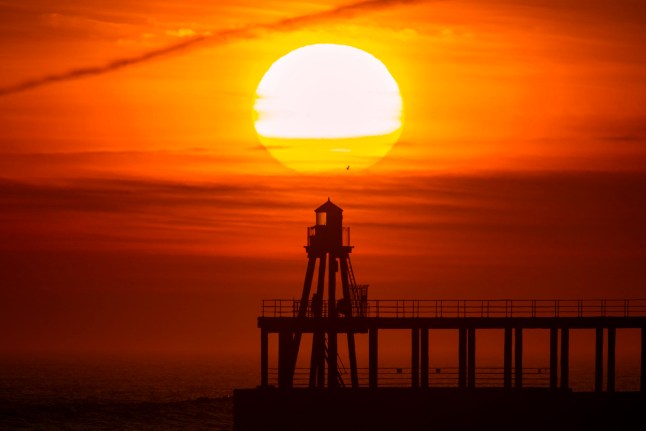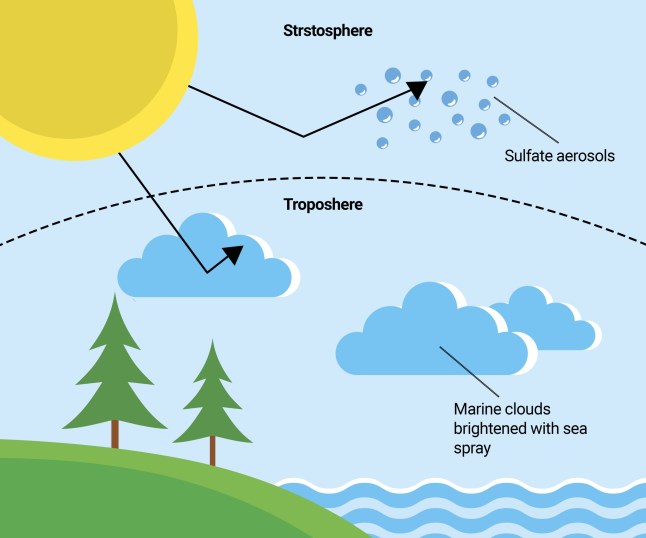
Scientists trialling experimental methods to try and fight global warming could be given the green light to start ‘dimming the sun’ within weeks.
The Advanced Research and Invention Agency (ARIA), sponsored by the government, funds experimental studies and research programmes.
It’s set aside £56.8million for projects aiming instead to create climate cooling, using measures such as injecting aerosols into the atmosphere or brightening clouds to reflect more sunshine.
If the projects get the green light from the government, which is expected to happen in the space of weeks, Aria will start carrying out ‘small controlled outdoor experiments on particular approaches’, The Telegraph reports.
The plans have sparked conspiracy theories that the UK government is trying to take control of the world’s weather – as well as fears that we could get ill or starve due to a lack of sunlight impacting crop growth.
But one expert has told Metro that the day-to-day impact of these techniques on the average person would be pretty tiny.

Professor Mark Symes, programme director at Aria, explained: ‘Decarbonisation is vital, but our current progress puts us at risk of triggering a large number of temperature-induced climate tipping points.
‘This programme will explore critical unanswered questions as to how (or whether) we might cool the Earth safely and responsibly on the timescales required to avoid climate catastrophe.
‘One of the missing pieces in this debate was physical data from the real world. Models can only tell us so much.
‘Everything we do is going to be safe by design. We’re absolutely committed to responsible research, including responsible outdoor research.
‘We have strong requirements around the length of time experiments can run for and their reversibility and we won’t be funding the release of any toxic substances to the environment.’
Geoengineering projects which try to alter the climate artificially can be controversial, with fears that these interventions could have damaging knock-on effects.
But amid fears that carbon dioxide levels aren’t falling fast enough, scientists are trying to take a different approach to prevent global warming from continually getting worse.
The biggest areas of research so far are sunlight reflection methods, where aerosols are released into the stratosphere to reflect the sun, and marine cloud brightening, to make clouds more reflective and send sunlight back into space.
Scientists think these methods could work off the back of the Bárðarbunga volcano erupting in Iceland in 2014, where huge amounts of sulfur dioxide spewed into the atmosphere.
This made the clouds brighter and led to the planet cooling down – so it’s hoped these effects could be replicated worldwide.
Plus, clouds above busy shipping routes in the world’s oceans also tend to be far brighter than usual, which could be caused by the particles released by ship engines when burning fuel.
Alistair Duffey is a PhD student at UCL, having completed his undergraduate and masters degrees at Oxford University.
His research revolves around climate modelling the potential impact of aerosol injection into the atmosphere – but he tells Metro scientists can’t rely on digital projections forever.
‘ARIA is trying to fund small-scale testing, which is a controversial step as it’s risky to start doing anything outdoors,’ Alistair explained.

‘But I would also stress that there are risks with not finding these things out. If we only rely on modelling we can’t find out if we are wrong until late in the game.
‘It’s important to do real-world testing on a small scale where the impacts are small.
‘It’s important to research these techniques and understand them.
‘We don’t know enough to make a decision on this yet, like what would the impact on crops be, people are doing that research but it’s not solved yet and that’s the sort of question our research needs to answer.’
While geoengineering is controversial within the scientific community, concerns are much more widespread.
One commenter on Reddit asked ‘why does the UK think they get to dim the sun for the rest of the world without our permission?’, with another likening the move to a monologue by character Morpheus in The Matrix about humans blocking out the sun.
James Melville, a pro-farming commentator, said on X: ‘Britain is a place where there’s low amounts of sunshine and yet the government is willing to spend £50million of taxpayers’ money on dimming the sun, while plastering prime farmland with huge solar panel developments – which require sunshine. You couldn’t make this stuff up.’
While another X user said: ‘We all know why they want to dim the sun. It’s because it will make us ill, farmers will struggle with their crops so we will go hungry.
‘These people need locking up and we shouldn’t let them get away with this. This is a crime against humanity.’
Some previous research has warned of potentially devastating consequences if artificial cooling techniques are used and then abruptly stopped.
A study from Rutgers University in New Jersey, published in 2018, called the technique a ‘risky strategy’ and warned it could trigger severe droughts, flooding, or cyclones.
Alistair suggested the phrase ‘dimming the sun’ is a bit misleading, as their work wouldn’t actually have any impact on the huge ball of gas about 93million miles away from Earth.
If these techniques were put in place, the impact on the average person would probably be pretty low, he said – and the impact if not enough is done to slow global warming and reach net zero would be much worse.
Plus, this research being carried out by ARIA in the UK does not mean our government would have full control over the ‘world’s thermostat’, he added – if the outcomes and results were viable, the decision to implement them would need to be global.
‘Climate change is a serious problem which will cause major harms to vulnerable people,’ Alistair explained.
‘We have not cut emissions as much as we needed to do, and in the coming decades many people will suffer from the impact of climate change.
‘It’s possible if we were to implement these techniques, it might be visible for some people at some times of day.
‘There are a range of ideas out there trying to cool down the planet by reflecting sunlight, and the evidence suggests they might help, so I think we have to take those ideas seriously.
‘We’re talking about small changes, it would have to be turned on quite slowly – a 1% reduction in sunlight, causing about 1°C of cooling, after 50 years.’
Get in touch with our news team by emailing us at webnews@metro.co.uk.
For more stories like this, check our news page.
MORE: Nasa finds mysterious ‘Skull Hill’ on Mars and doesn’t know where it came from
MORE: How to see Lyrids meteor shower tonight and best spot to view oldest shooting star display










